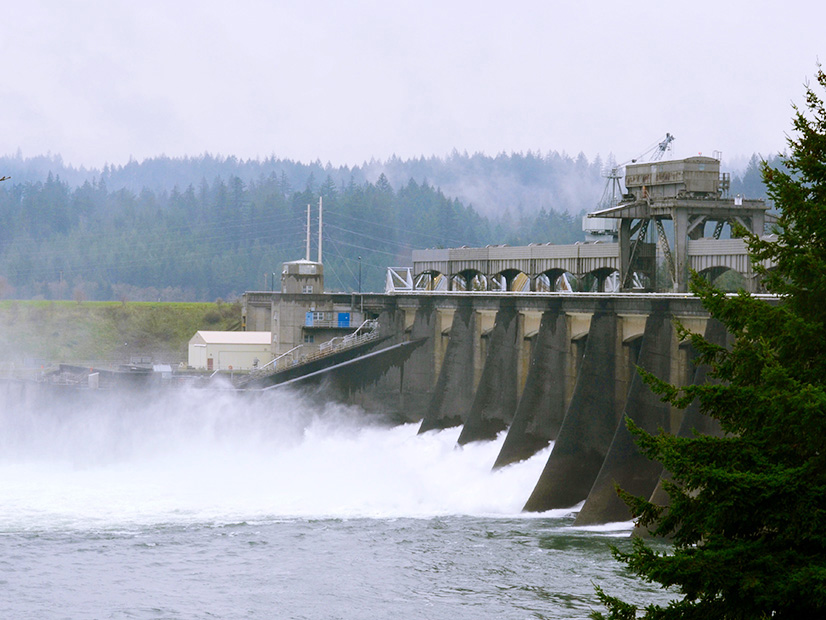The Bonneville Power Administration last week proposed to hold key power and transmission rates mostly flat over its next two-year rate cycle — and said it might cut rates this year — in light of a “strong” financial performance over the past 12 months.
The federal power marketing agency said steady rates will provide a “buffer against market volatility” for its customers, which largely consist of publicly owned utilities across the Pacific Northwest. Those utilities serve residents with some of the cheapest power in the U.S., most of which is generated by the region’s extensive network of hydroelectric dams.
“This is one of those bountiful years where all the elements and timing came together in such a manner that we can consider staving off inflation for another two years by keeping rates flat for our power and transmission customers,” BPA Administrator John Hairston said in an announcement Friday.
The agency said it earned $964 million in net revenues during fiscal year 2022, far outdistancing its target of $172 million.
“Each quarter, we have signaled our expectations that Power and Transmission were expected to have a solid year, and I’m happy to report that was in fact the case, with both business lines significantly beating net revenue targets,” Marcus Harris, BPA’s acting CFO said in a press release Thursday.
During its quarterly business review on Wednesday, the agency said it would consider using its financial reserves to reduce rates in FY 2023, which began Oct. 1.
Friday’s announcement kicked off the formal process for BPA’s power rate case (BP-24) and transmission rate proceeding (TC-24) for fiscal years 2024/25 (Oct. 1, 2023 to Sept. 30, 2025). Agency staff will officially publish initial proposals for the new power and transmission rates on Dec. 2, the same day as a pre-hearing conference to discuss the plans, but both plans are already available online. The proposed rates were the subject of a series of stakeholder meetings held this summer.
BPA’s power rate schedule consists of four categories of primary rates for federal energy sales, including the:
- Priority Firm Power Rate (PF-24), or “Tier 1,” which applies to firm power sales to BPA’s public body, cooperative and federal agency customers;
- New Resource Firm Power Rate (NR-24), which applies to firm sales to investor-owned utilities and public customers serving new large, single loads. (BPA is forecasting no sales at this rate during the BP-24 period);
- Industrial Firm Power Rate (IF-24), which is applicable to firm power sales to Direct Service Industrial customers; and
- Firm Power and Surplus Products and Services Rate (FPS-24), applicable to “sales of various surplus power products and surplus transmission capacity for use inside and outside the Pacific Northwest.”
Tier 1 “non-slice” contracts represent the majority of BPA’s power sales. “Non-slice” refers to a type of contract in which the customer is guaranteed a specified volume of energy regardless of conditions on the hydro system; in contrast, total volumes delivered to “slice” customers can vary based on availability.
In a notice filed in the Federal Register on Friday, BPA said non-slice rates will remain flat at an average rate of just under $35/MWh. But when slice rates are considered, average Tier 1 prices should actually decline slightly, according to the notice.
“The individual experience — slight increase/decrease/flat — of customer utilities will vary based on what products they use and the ways in which they use them,” BPA spokesperson Kevin Wingert told RTO Insider in an email.
In the notice filed Friday, BPA said it expects to sell power to only one industrial customer at the industrial rate over 2024/25, but that customer can expect to see significantly higher costs during the most energy-constrained months, with December prices rising from $51.99/MWh to $63.40/MWh, and August rising from $49.10/MWh to $73.29/MWh. That is in part a reflection of changing expectations for river flow patterns in the Northwest — as well as summer cooling needs — caused by climate change.
BPA’s proposal would extend current transmission rates unchanged into FY 2024/25, with “main grid” and “secondary system” — or lower-voltage — charges remaining at $0.0774/mile and $0.76/mile, respectively.
The agency operates about 15,000 miles of transmission, about 75% of the system in the Northwest.




